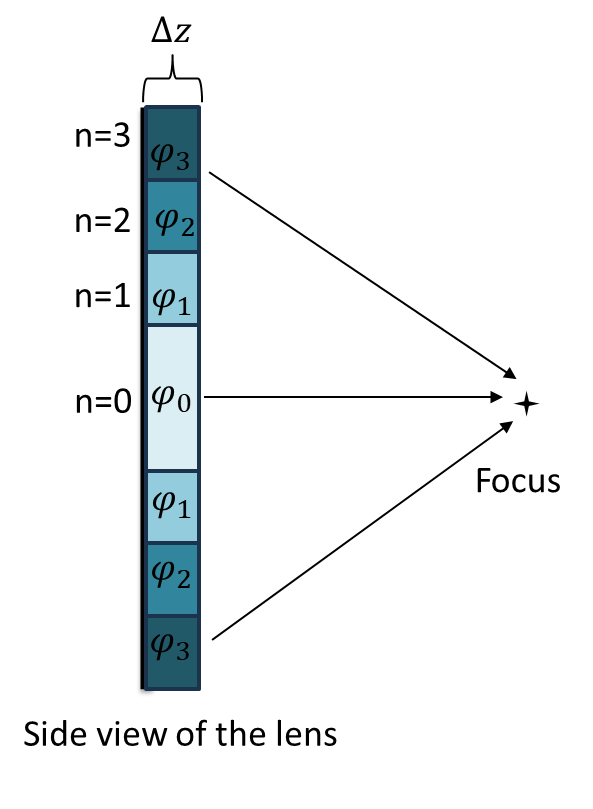
Methods of Adaptive Beam Focusing
Abstract
This white paper explores adaptive methods for dynamic acoustic beam focusing, a technique used to concentrate sound energy at a specific spatial location by aligning the phases of propagating wavefronts. While the principle of focusing is commonly associated with optics, similar mechanisms apply to acoustic systems, enabling enhanced directionality, intensity, and resolution in applications ranging from medical imaging to advanced acoustic communication.
We begin by outlining the foundational concepts of wave superposition and phase manipulation, emphasizing how constructive interference enables acoustic focusing. The paper then presents three distinct approaches to achieving dynamic focusing: (1) time delay control across multiple channels, (2) acoustic lenses—both variable thickness and sectioned designs—and (3) frequency-controlled binary lenses. Each method allows real-time adjustment of the focal point by controlling phase contributions through timing, material properties, or input frequency.
Experimental demonstrations and recent advancements in tunable lens materials and design are discussed to highlight the feasibility and versatility of these techniques. The presented strategies offer scalable solutions for precision acoustic control in both scientific and commercial applications.
Introduction
Focusing refers to the concentration of wave energy at a designated spatial location. This principle is broadly applicable across various wave phenomena, including sound waves and electromagnetic waves (such as light). By directing wave energy into a smaller spatial region, focusing enhances both intensity and resolution at the targeted point. A common example is the magnifying glass, which concentrates sunlight into a single point, amplifying its energy. Similarly, in photography, adjusting the focal length of a camera lens enables users to dynamically tune the focal point for optimal image clarity.
While optical focusing is widely understood, it is less commonly recognized that similar principles govern the behavior of sound waves. In fact, intuitive acoustic focusing is used frequently in everyday life—for instance, when individuals cup their hands around their mouths to project and direct their voice, thereby concentrating acoustic energy in a particular direction.
In acoustics, sound waves can be guided to converge at a predetermined focal point where the pressure amplitude surpasses that of the surrounding medium. This phenomenon significantly enhances the clarity, directionality, and immersive quality of acoustic fields. Beamforming techniques exploit this principle, allowing sound to be focused in a specific direction. For example, loudspeakers can be engineered to deliver audio to a listener in a particular location, while microphone arrays can isolate signals from a targeted source while suppressing ambient noise.
This white paper does not aim to comprehensively cover all aspects of beamforming. Rather, it centers on methods for achieving and dynamically adjusting acoustic focus—similar to the real-time focal adjustments of optical systems.
Dynamic acoustic focusing relies on a fundamental understanding of wave behavior and superposition. All wave types—including acoustic and electromagnetic waves—are characterized by oscillatory cycles comprising high-amplitude regions (peaks) and low-amplitude regions (troughs). The phase of a wave defines its position within one oscillation cycle at any given time or location. For a simple sinusoidal wave, the amplitude as a function of time can be expressed as:
Where:
is the maximum amplitude
- φ is the phase, defined as:
Here:
is the angular frequency, with
is the speed of sound in the medium
is the wavevector
is time
For instance, at , if
, then
, and the wave begins at zero amplitude. If
, the wave starts at maximum amplitude
, indicating a phase shift corresponding to a cosine wave.
The principle of wave superposition is crucial. When multiple waves intersect at the same point and time, their amplitudes combine. If two waves have opposite phases (e.g., ), they destructively interfere and cancel each other:
Conversely, if they are in phase (e.g., both ad ), constructive interference occurs:
This principle extends to multiple waves and serves as the basis for dynamic beam focusing. (Note: this discussion assumes linear superposition; nonlinear effects become significant in complex media such as deep water.)
Phase can be manipulated through two primary mechanisms:
- The propagation distance
(in
)
- The emission timing
(in
)
Controlling these variables allows for constructive interference at a specific location, resulting in a focal point with increased energy concentration. While various methods can be used for dynamic focusing, the following sections outline three distinct approaches to achieving dynamic acoustic focusing.
Methods for Achieving Dynamic Acoustic Focusing
Time-Delay Beamforming
Phase alignment can be achieved by controlling the time delay of wave emissions. Consider a simplified one-dimensional system (Figure 1) with three independent sound sources (channels). The objective is to focus wave energy at a point f.
For the central source (Channel 0), the phase term is:
Assuming , the focus lies at a distance from the source. If the wave from Channel 0 is arranged to arrive at the focal point with a phase of
, where n is an integer, the amplitude is maximized.
Channels located at different distances from the focal point (e.g., Channel 1 at distance ) experience additional phase shifts due to the extra distance their waves must travel. To ensure that all wavefronts arrive in-phase at the target location, each Channel must incorporate a specific time delay (e.g.,
for channel 1) to compensate for this difference. These time delays are carefully calibrated so that the waves from all sources constructively interfere at the focal point. By dynamically adjusting these emission delays in real time, the focus can be shifted spatially, enabling adaptive beam steering.

Acoustic Lensing
In contrast to Method 1, which utilizes multiple emission sources, Method 2 employs a single source paired with an acoustic lens. The lens is composed of materials with a different speed of sound than the surrounding medium, enabling phase manipulation via wave speed variation. Since the angular frequency , phase is inherently dependent on the speed of sound in the lens material.
Variable Thickness Lenses
An acoustic lens with dynamically adjustable thickness modulates the time waves spend traversing the lens material. For example, a curved lens—with greater thickness at the center—delays peripheral rays more than central rays, especially if the material propagates sound faster than the surrounding medium. Modifying the lens curvature in real time alters the thickness profile and hence the phase delays, enabling dynamic focusing.

Dynamic curvature control has been experimentally demonstrated, notably through liquid-filled lenses where internal pressure alters the curvature profile (e.g., the study by Li et al1)
Sectioned Lenses2,3
Another approach involves sectioned lenses (Figure 3.) with uniform depth of but filled with different internal materials or fluids, each exhibiting a distinct sound speed. As sound waves travel through these sections, they undergo varying phase shifts . If water is used in each section, for instance, adjusting the salinity levels can change the speed of sound, thereby modifying the phase shift. By dynamically altering these fluid properties, the phase contribution from each section can be precisely tuned in real time.
Rostami and Mobley2 demonstrated a concentric channel lens filled with saltwater solutions at varying concentrations. These variations modulate the phase profile across the lens aperture, allowing for dynamic focus control.

By appropriately adjusting the salt concentration—and thus the sound speed—in each channel, the emitted waves can be phase-aligned at the target, achieving constructive interference at the desired focal point.
Frequency-Dependent Phase Manipulation
Phase modulation can also be achieved through frequency control. Binary acoustic lenses consist of alternating structures, such as a lens made with channels where the walls are composed of Polylactic Acid (PLA) and the channels are filled with water. These materials exhibit different acoustic propagation speeds, creating a phase shift profile across the lens. Since the phase shift introduced by each section is frequency-dependent, altering the input frequency changes the effective phase delay imparted by each element. This, in turn, shifts the location of constructive interference, thereby moving the focal point.
This approach has been experimentally demonstrated by Hu et al.4 Binary acoustic lenses hold significant potential for dynamic focusing on applications like medical ultrasound, non-invasive brain stimulation, and targeted acoustic delivery systems.
Conclusion
These methods illustrate the versatility and precision of modern acoustic focusing techniques, particularly in applications where real-time adaptability is essential. Whether through time-delay synchronization, variable acoustic lens designs, or frequency modulation, dynamic control over sound field focusing can be tailored for a wide range of environments and technologies—from medical imaging to advanced acoustic communication systems.
References
- Z. Li, R. Guo, C. Fei, D. Li, D. Chen, C. Zheng, R. Wu, et al., “Liquid lens with adjustable focus for ultrasonic imaging,” , doi: 10.1016/j.apacoust.2020.107787. doi:10.1016/j.apacoust.2020.107787
- Sina Rostami, and Joel Mobley, “Liquid Channel Tunable Lenses for Phased-based Ultrasonic Beamforming.,”
- Sina Rostami, The characterization of radiation forces using tunable acoustic lenses, (Oxford, University of Mississippi , 2025).
- Z. Hu, Y. Yang, L. Xu, Y. Hao, and H. Chen, “Binary acoustic metasurfaces for dynamic focusing of transcranial ultrasound,” , doi: 10.3389/fnins.2022.984953. doi:10.3389/fnins.2022.984953